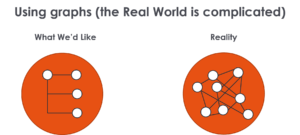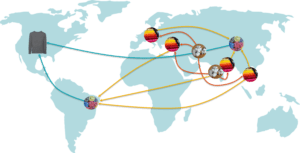Globalization has undoubtedly transformed the supply chain. With the world at our fingertips, we can now produce high-quality goods more quickly and more cost effectively than in the past. However, globalization, alongside all its benefits, has also made supply chains more complex—making supply chain management a more challenging task.
In an ideal world, supply chains for any product are linear: one supplier supplies another, then another, in an easy-to-understand progression to the final finished good. But with globalization, brands can source from multiple suppliers from all over the world, making the supply chain a rather complex, interconnected network.

We need a new technology to manage this complexity; this is where graph databases come in. As opposed to relational databases, a common data model which stores rigidly structured data into predetermined rows and columns, graph databases assemble nodes and the relationships between them into connected structures. While relational databases were popular beginning in the 1980s, the globalized world has necessitated a shift from relational to graph.
You can find more information on relational vs. graph databases on Neo4j’s website.
What does this mean for supply chains?
Graph databases are used for many popular applications. Most notable among these are social networks such as Facebook and LinkedIn, which are defined by their ability to connect global networks. But graph databases also deliver value for supply chain management, thanks to three key attributes:
- Scalability: Graph databases can keep growing and easily adapt to the size of any supply chain network. Nodes can be added on as needed, making graphs appropriate to map even very large supply chains—which is the case for many of the products we have today.
- Complexity: Because graph databases are based on interconnections between nodes, they can store data for very complex networks. If a product relies on multiple suppliers spread around the world—who in turn rely on several suppliers on their own—graphs can easily handle this data.
- Agility: Regardless of scale or complexity, graph databases can perform robust searches on data. This agility translates into the ability to quickly search vast product supply chains for a component or material that may be affected by a health, social, or environmental issue.
Graphs in the real world
To provide a more concrete example, let’s say a cotton t-shirt is manufactured and sold in the United States. Thanks to globalization, the fabric for this t-shirt comes from suppliers in both China and Brazil. These Chinese and Brazilian suppliers source thread from Poland, Turkey, India, and Vietnam, which is made from cotton grown and processed in Pakistan and India. But the Indian cotton farm also provides cotton directly to the Brazilian supplier for the manufacture of fabric.
The cotton t-shirt’s supply chain now looks something like this:
 The story behind this t-shirt involves eight suppliers who work with each other in a variety of combinations. Relational databases would struggle to properly track these interweaving connections, but this is exactly where graph technology excels.
The story behind this t-shirt involves eight suppliers who work with each other in a variety of combinations. Relational databases would struggle to properly track these interweaving connections, but this is exactly where graph technology excels.
Graph technology is a game changer for today’s modern society, which is increasingly interconnected. The ability to connect people online—whether this means friends, colleagues, or business partners in different countries—is crucial for tackling supply chains in the era of globalization.









